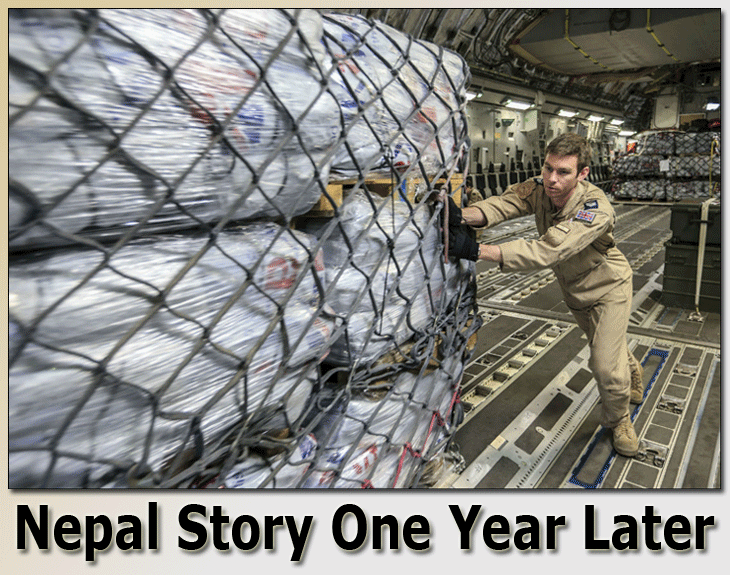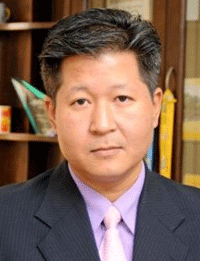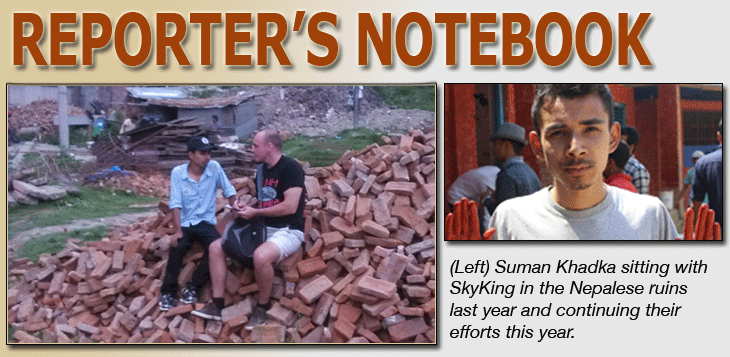
 On
the anniversary of the first Nepal quake on April 25
2015, FlyingTypers caught up with Gagan Mukhia,
Country Manager of DHL Express Nepal. On
the anniversary of the first Nepal quake on April 25
2015, FlyingTypers caught up with Gagan Mukhia,
Country Manager of DHL Express Nepal.
As reported by our correspondent
a year ago, on the day the first 7.8 magnitude quake
shattered the Himalayan country, most DHL staff were
enjoying a team bonding picnic on a pleasant hill some
30 minutes outside the capital Kathmandu.
They saw monuments and
buildings in a nearby town collapse as the ground around
them shook.
Many panicked about the
safety of their families. The terror was mirrored around
Nepal.
Even for those whose families
escaped unscathed, some 90 aftershocks over the next
few months added to the sense of insecurity.
They also added to the
damage. Almost 9,000 people were killed by the quakes,
thousands more were injured, and almost a million houses
were left partially or completed damaged.
In the immediate aftermath,
DHL’s Disaster Response Team—currently helping
Ecuador deal with its own quake—were quickly on
the scene. Aided by Gagan’s local contacts, they
were able to vastly improve the handling operation airside
at Tribhuvan Kathmandu International Airport.
But a year on, what’s
the situation like in Nepal?
“Every citizen of
Nepal is worried a major earthquake could happen again,”
said Gagan by phone from Kathmandu. “Reconstruction
is progressing and the monsoon season is coming in June.”
The reconstruction effort
has indeed moved slowly. Nepal’s government has
not rebuilt a single permanent house or school since
the earthquakes started a year ago, according to the
Wall Street Journal. Indeed, the authority in charge
of reconstruction only became a legal entity in December
and did not distribute its first funds—some $4.1bn
was donated by international agencies last June—until
March 2016 as politicians instead battled over a new
constitution.
Fallout from of the constitutional
dispute included the unofficial closure of the border
with India, which saw fuel rations introduced across
Nepal, inflation spike, and GDP growth grind to a halt.
With limited fuel, NGOs were forced to close down or
scale back relief operations.
“People in the affected
areas are still living outdoors and nothing to help
them has reached them so far,” said Gagan. “We
are hoping something will happen in the next few months.”
Like most businesses in
Nepal, DHL is still recovering. “We’re not
back to the same momentum we had a year ago,”
he explained. “There was no fuel or cooking gas
coming to Kathmandu. We had some rationed fuel, improvised
a car pool, and made deliveries by bicycle around Kathmandu
or used what public transport there was still available.”
The key truck link to
Indian ports from land-locked Nepal is now open, fuel
deliveries are arriving, and gas prices have fallen.
The airport is also operating normally.
But inflation of over
10 percent makes rebuilding businesses and lives difficult.
Remittances are also down as Nepal’s army of overseas
workers have been too short of funds to travel, or too
afraid to leave their families. And key industries such
as tourism and handicraft exports are in dire straits.
DHL is continuing to focus
its operations on Kathmandu, which accounts for 90 percent
of its revenues in Nepal. Outside the capital, many
roads have still not been rebuilt.
“We’re hoping
the government implements measures to improve the economy
soon,” said Gagan. “Many
people are living outdoors. If the monsoon comes before
they get help it will be very difficult.”
SkyKing
 After spending time in
Nepal last year our reporter on the humanitarian disaster,
Mike ‘Sky’ King—exasperated with the
ineffectiveness of the relief efforts—started
working with a brave teenager called Suman Khadka, who
took it upon himself to help his devastated village. After spending time in
Nepal last year our reporter on the humanitarian disaster,
Mike ‘Sky’ King—exasperated with the
ineffectiveness of the relief efforts—started
working with a brave teenager called Suman Khadka, who
took it upon himself to help his devastated village.
This became a charity
called Suman’s Story – Direct Aid for Nepal.
Last year the charity distributed emergency food packages,
70 tons of rice, tarpaulins, and water filters. 600
chickens were also bought to set up a chicken farm.
Families
In Peril
But Palchok and its 586
families are still in dire straits.
They have received no
assistance from either NGOs or the government.
Almost all of the villagers
are still living in temporary accommodation and many
are suffering from basic poor health. The majority of
the illnesses contracted by Palchok residents fall into
the primary healthcare category such as skin infections
and gastrointestinal ailments, ailments preventable
if water access, sanitation, hygiene, and nutrition
are improved.
Doing
The Most Good
Mike and his team have
now completed a needs assessment of Suman’s village
and they are trying to raise USD $8,000 (https://www.gofundme.com/2m9exbmk)
to set up and operate a drop-in health clinic complete
with part-time nurse and receptionist.
This limited expenditure
will cover the cost of all medicines, educational materials,
and the employment of staff over a two-year period.
“Our needs assessment
of the area shows this will vastly improve the lives
of the 586 families in Palchok and the surrounding area
who have received almost no help from the government
or major NGOs since the village was devastated by a
series of major earthquakes in 2015,” said Mike.
“With any additional
funds raised we will expand the scope of those we are
helping to more villages.”
Can
Somebody Help?
“If we could get
some sponsorship from a major airline, forwarder or
integrator we could do so much more.”
If you would like to help
Suman and Nepal here please go here:
You can also contact Mike
directly about this on: mikeking121@gmail.com
For more information please
read regular updates here:
Geoffrey
|






